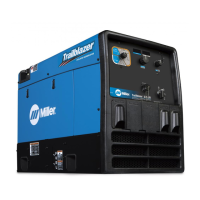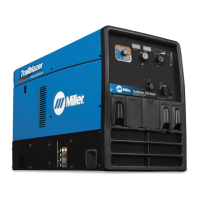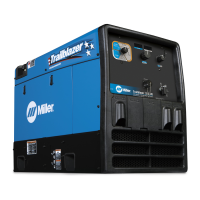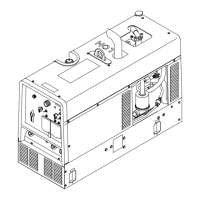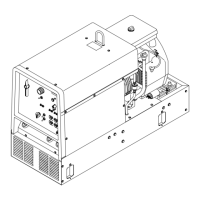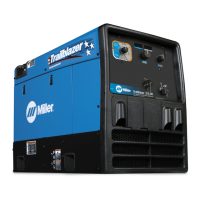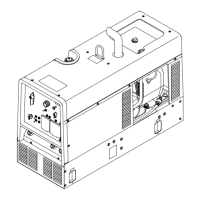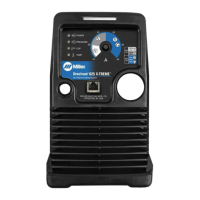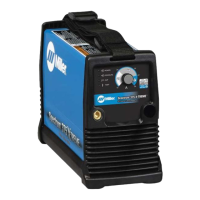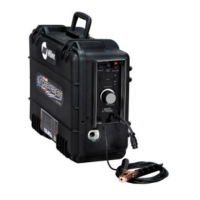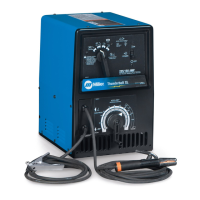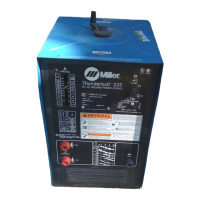What to do if my Miller Welding System displays 'Engine Battery Error'?
- SStacey BoydAug 2, 2025
If your Miller Welding System shows an 'Engine Battery Error', the first step is to check the battery.
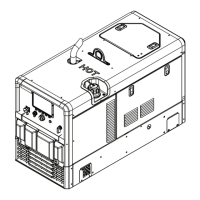
What to do if my Miller Welding System displays 'Engine Battery Error'?
If your Miller Welding System shows an 'Engine Battery Error', the first step is to check the battery.
| Engine Power | 24.8 hp (18.5 kW) |
|---|---|
| Rated Output | 300 A |
| Open Circuit Voltage | 70 Volts |
| Output Range | 40-330 Amps |
| AC Generator Output | 10, 000 Watts Peak, 9, 500 Watts Continuous |
| Fuel Tank Capacity | 12 Gallons (45.4 Liters) |
Explains hazard symbols and their meanings for safe operation.
Details hazards specifically related to arc welding processes and precautions.
Covers hazards associated with the engine, including battery, fuel, and moving parts.
Outlines dangers related to compressed air systems and components.
Lists various hazards encountered during setup, use, and upkeep of the equipment.
Provides warnings regarding chemical exposure as required by California law.
Discusses electromagnetic fields and their potential interference with medical devices.
Identifies the location of the serial and rating label for product identification.
Details key specifications for welding modes, power output, and engine.
Outlines operating and storage temperature ranges and IP rating.
Provides physical dimensions, weight, and safe operating angle limits.
Explains duty cycle limitations and overheating prevention measures.
Presents graphical data on fuel usage for welding and auxiliary power.
Displays voltage and amperage output capabilities for stick welding.
Displays voltage and amperage output capabilities for TIG welding.
Shows the generator's power output characteristics at different loads.
Provides guidelines for safe and proper installation, including mounting and clearance.
Details the procedure for grounding the generator to a vehicle frame for safety.
Explains how to properly route the ground cable for safe connections.
Outlines essential checks before starting the engine, focusing on fluids.
Instructs on safely connecting and replacing the unit's battery.
Identifies and explains the weld output terminals and their functions.
Guides on correctly connecting weld output cables to terminals.
Identifies and explains the functions of the front panel controls and interfaces.
Describes the primary display screen and its various indicators.
Details the main menu structure for navigating settings and functions.
Explains how to access and modify system settings like VRD and WLC.
Guides on selecting and configuring different welding processes.
Details how to adjust specific parameters for various welding processes.
Explains the automated setup feature for quick welding parameter selection.
Provides step-by-step instructions for initiating a stick welding arc.
Outlines connections and settings for MIG welding with solid wire.
Explains how engine speed adjusts automatically based on load requirements.
Describes the interface for tracking and managing service intervals.
Provides a schedule for regular maintenance tasks based on operating hours.
Gives instructions for replacing the engine air cleaner element.
Covers essential maintenance tasks for the engine, including oil, fuel, and coolant.
Identifies fuses and circuit breakers that protect the unit from overloads.
Lists error codes displayed on the panel and their potential causes/solutions.
Provides solutions for common welding output issues and arc problems.
Offers remedies for issues related to generator power output.
Lists common engine problems and their recommended solutions.
Addresses issues related to battery charging and jump-starting functions.
Presents the first part of the unit's electrical circuit diagram.
Presents the second part of the unit's electrical circuit diagram.
Guidelines for choosing compatible electrical equipment for generator use.
Instructions for safely grounding the generator when mounted on a vehicle.
Explains how to calculate power needs for various types of equipment.
Illustrates common methods for connecting the generator to a standby power system.
Provides guidance on selecting appropriate extension cords based on load and length.
